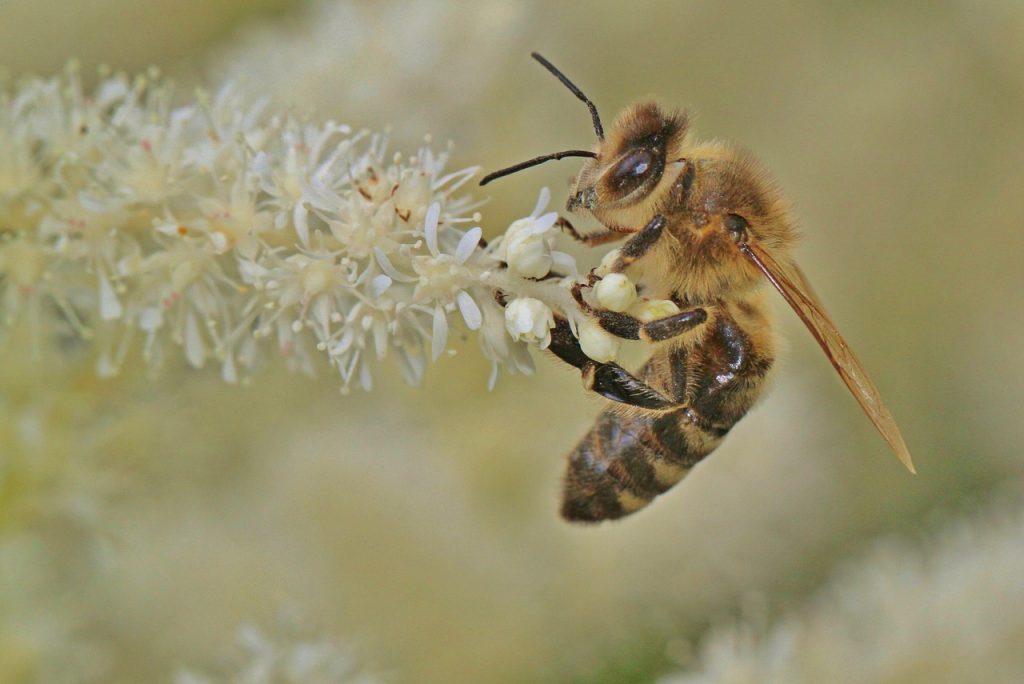The Anatomy of the Honey Bee


We already know that the honey bee is a fascinating creature with lots of interesting behaviors. Although they are small, they play a huge role in pollination and agriculture throughout the world. Without them, our food supply would look quite different than it does today.
What the honey bee lacks in size, it makes up for in efficiency. Every part of a bee’s body is perfectly designed to help the bee perform its role in the world. Today we are going to talk more about the amazing anatomy of a honey bee and how each body part supports the bee in its life functions.
The Anatomy of a Honey Bee
A honey bee’s body can be divided into three distinct sections – head, thorax and abdomen. We will take each section separately and discuss the most important body parts that can be found there. Here we go!
The Head
Eyes
Honey bees have two compound eyes and three simple eyes. Each set of eyes serves different functions and gives the bees different advantages. What’s the difference between the two?
Compound eyes are the larger eyes that are made up of many hexagonal shapes. This allows the bee to see in every direction and to have polarized vision. Just like polarized sunglasses that humans might wear, polarized vision helps the honey bee navigate more effectively and protects their eyes from light. The vision in the compound eyes also helps bees to get from the hive to their food source and back.
Simple eyes are located on the top of a bee’s head. These eyes are made up of a single lens and are sensitive to UV light. The UV light helps bees to find pollen and aids in their orientation.
Proboscis
This feature of the honey bee can extend longer than the body of the bee itself. It is almost like a human tongue. Its job is to reach deep down into flowers to extract nectar. Bees also use the proboscis to groom each other and the queen.
Antennae
Antennae act as the sensory center of the honey bee. They allow the bee to touch, smell and taste. Even though bees don’t have ears as we know them, the antennae even allow bees to “hear.” Antennae have mechanoreceptors that respond to vibrations in the air allowing them to touch and hear. They also have 170 odor receptors that give them an advanced sense of smell.
Thorax
In the middle a bee’s body, you will find the thorax. The body parts found in this section aid the bee in motion and collecting pollen.
Legs
Honey bees have three pairs of flexible legs that are designed to help them land on any surface. They have claws and sticky pads that help them land and stay put anywhere. The front legs help keep the antennae clean and able to act as the sensory organ of the bee. The back legs of a worker bee are tailored to help them collect and carry pollen.
Wings
Honey bees have two pairs of wings – larger front wings and smaller back wings. Both sets help bees fly at speeds of up to 15 miles per hour.
Pollen Basket
Ever wonder how honey bees transport pollen from flower to flower? Bees have a structure called a pollen basket behind their back legs. When a bee visits a flower and becomes covered with pollen, it brushes the pollen from its body into the pollen basket where it is kept in place by a bunch of hairs.
Abdomen
Honey Stomach
Nectar collected by the honey bee is stored in the honey stomach. Once the bee returns to the hive, the nectar is regurgitated and then stored in the cells of the hive. A bee can carry approximately 75mg of nectar in the honey stomach.
Stinger
Bees are known for their sting, but did you know that only female bees have stingers? Drones do not have stingers, so you never have to worry about being stung by one of these bees. Worker bees and queen bees do have stingers, but they vary slightly from each other. Worker bees have a barbed stinger. When they sting, the barbed stinger tears from the bee’s body and causes the bee to die. The queen’s stinger, on the other hand, is not barbed so she can sting multiple times without dying.
There is so much more to the anatomy of a honey bee, but this is a good overview of the most important parts and their functions. The next time you see a hive or swarm on your property, take a minute to appreciate the amazing makeup of the honey bee.
If bees are a hazard to your property or business, don’t try to remove them on your own. Contact D-Tek Live Bee Removal for safe and humane live bee removal and rehoming in San Diego County.
